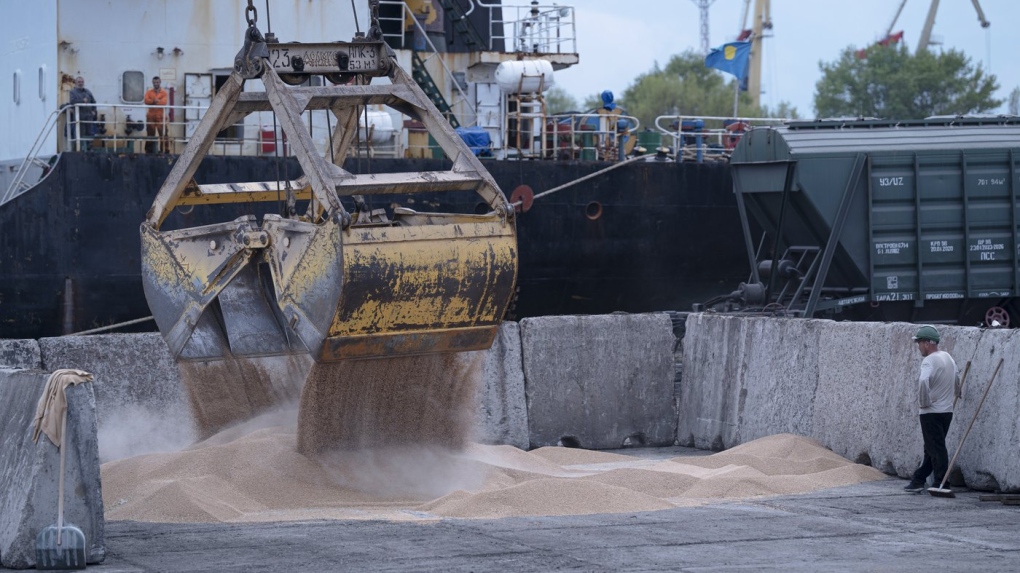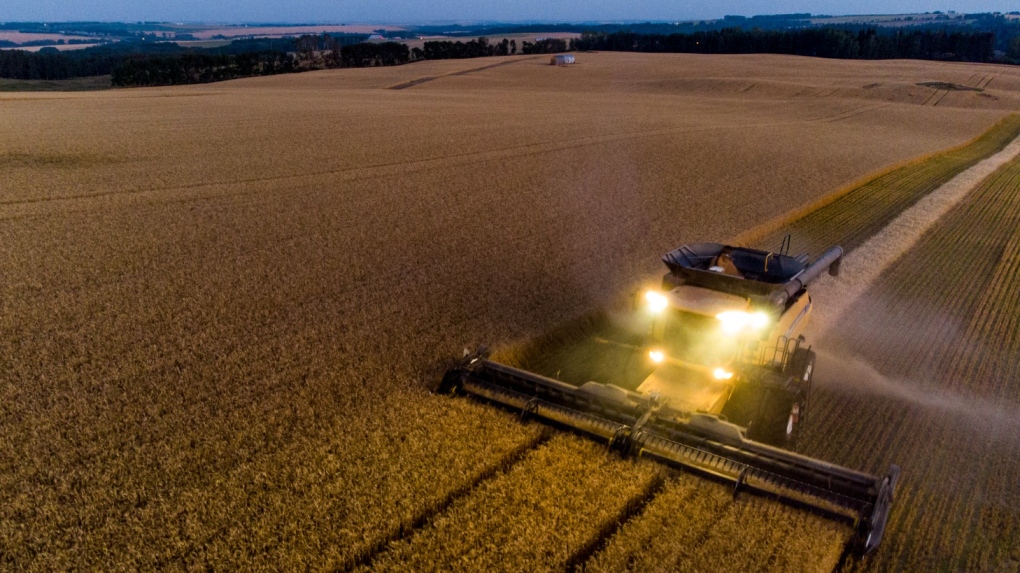Canada’s inflation rate tumbled to 2.8 per cent in June, reaching the country's target range for the first time in more than two years — what Deputy Prime Minister and Finance Minister Chrystia Freeland hailed as “a milestone moment.”
So why are Canadians still feeling the pinch at their local grocery stores?
Economists say there are a number of factors driving up food prices in Canada, which were up 9.1 per cent year-over-year in June. But they expect food inflation to slow over time.
“(There’s) a combination of very many different things pretty much working collectively to push food prices higher,” Claire Fan, an economist at RBC, told CTVNews.ca in an interview.
“Everybody would love there to be a single demon we could name, but the truth is that there's a bunch of little factors, there's a bunch of straws building up on the camel's back,” said Will Huggins, who teaches finance and business economics at McMaster University in Ontario.
Here's a look at some of the factors behind Canada’s high grocery prices and what to expect in the coming months.
CANADIAN DOLLAR DECLINES IN VALUE
Canadians may have noticed that fresh fruit and vegetables, in particular, are pricey.
Huggins said one of the reasons for that is that the value of the Canadian dollar has fallen against the U.S. dollar by about 10 per cent.
In May 2021, $1 CAD was the equivalent of 83 cents USD, whereas now, $1 CAD is worth roughly 75 cents USD.
 Deputy Prime Minister Chrystia Freeland grocery shopping in Toronto on Monday April 3, 2023. THE CANADIAN PRESS/Frank Gunn
Deputy Prime Minister Chrystia Freeland grocery shopping in Toronto on Monday April 3, 2023. THE CANADIAN PRESS/Frank Gunn
This decline in the value of the Canadian loonie means that whatever Canada imports from the U.S. is more expensive and prices of certain produce at grocery stores has increased to reflect the change.
“So everything we buy from America costs 10 per cent more than it did two years ago,” Huggins explained.
“Avocados are 10 per cent more expensive because we don't grow them here, lemons, oranges, anything that's like this that isn't grown in Canada has seen a sort of increase in its costs, simply because the price of the Canadian dollar doesn't buy as much.”
EXTREME WEATHER AND CLIMATE CHANGE
Adverse weather conditions are partly to blame for higher food costs.
With extreme weather events like droughts, wildfires and flooding becoming more frequent in Canada and around the world, as a result of climate change, Fan said farm production and supply chains are impacted, applying some pressure on overall food inflation.
Severe drought conditions in the Prairies, for example, caused domestic crop production to drop sharply in 2021.
Extreme weather is one of the major threats that RBC has identified for food inflation for the upcoming decade, Fan noted, because it will likely lead to “a lot more volatility and uncertainty.”
“When you have one weather event impacting one type of crop largely, you wouldn't see persistently high food inflation,” she explained.
“But when you have the scale of these severe weather events happening frequently enough, and especially in the United States, which is our top importer, where we import most of our fruits and veggies from … and we have this happening elsewhere as well, where we import some of our other grocery products, that's when it really becomes a problem.”
Throughout human history, the weather has “enormously affected” food production and costs, said Huggins, noting that extreme weather events “can complicate things without question” by damaging farm equipment and infrastructure, as well as creating a delay in getting materials or goods to the market, which has a direct cost as well.
However, barring “enormous climatic changes,” the economist said he doesn’t expect climate change to create “continued major pressure” on food prices in Canada and that the country could actually stand to benefit from certain climatological shifts.
“Even though there will be adjustment costs, obviously, our super cold country is about to become a little bit warmer, so it creates opportunities to some extent for us in that regard,” said Huggins.
“We will gain some, we will lose some without question, but compared to many other countries, we're in a great position when it comes to climate change.”
GEOPOLITICAL TURMOIL
The Russia-Ukraine war is another factor that has led to higher food prices in Canada.
Russia’s invasion of Ukraine in February 2022 resulted in additional upward pressure on global food prices due to the role the two countries play in agricultural and oil production. It led to a surge in prices of wheat, fertilizer and natural gas.
And while the potential impacts of the collapse of the Black Sea grain deal have yet to be seen, Huggins said there could still be reason for concern.
Brokered by the United Nations and Turkiye in July 2022, the deal allowed Ukraine to export grain from its seaports despite the ongoing war. Russia walked out of the deal last month after saying its demands to ease sanctions on its own grain and fertilizer exports had not been met.
 Workers load grain at a grain port in Izmail, Ukraine, on April 26, 2023. NATO said Wednesday July 26, 2023, it was stepping up surveillance of the Black Sea region as it condemned Russia’s exit from a landmark deal that allowed Ukrainian grain exports through the Black Sea. (AP Photo/Andrew Kravchenko, File)
Workers load grain at a grain port in Izmail, Ukraine, on April 26, 2023. NATO said Wednesday July 26, 2023, it was stepping up surveillance of the Black Sea region as it condemned Russia’s exit from a landmark deal that allowed Ukrainian grain exports through the Black Sea. (AP Photo/Andrew Kravchenko, File)
The damage to Ukraine's food growing and processing industry during the war is also going to create “major problems,” he said.
“We usually keep inventory against disruptions, but the fact is that there's not as much coming into the back end of the warehouse anymore; certain things are actually starting to seriously get disrupted,” he said.
“The collapse of the Black Sea grain deal has the potential to create a lot of problems. The grain deal worked a little bit for a while, but we're going to start feeling the pain that we anticipated last year.”
Fortunately, North America is “largely insulated” from these problems because it does have a lot of domestic food production, Huggins noted.
“So as much as it hurts us, we have to remember that we don't have to make questions about feeding which kid,” he added.
SUPPLY CHAIN ISSUES STEMMING FROM THE PANDEMIC
Global supply chain bottlenecks stemming from the COVID-19 pandemic drove up food prices as well, but the supply chain has started to normalize, both Fan and Huggins noted.
 A family harvesting their wheat crop near Cremona, Alta., Tuesday, Sept. 6, 2022. THE CANADIAN PRESS/Jeff McIntosh
A family harvesting their wheat crop near Cremona, Alta., Tuesday, Sept. 6, 2022. THE CANADIAN PRESS/Jeff McIntosh
The bottleneck for machinery used on farms is one example that has driven up prices in Canada, said Huggins, adding there is a “backlog of orders for farm machinery in Canada stretching into next year.”
“The machinery backlog is working its way out; we don't have as many supply side problems in terms of COVID compared to say, a year or two years ago,” he said.
“So we are still experiencing some of this sort of COVID hangover in the agricultural sector.”
LABOUR SHORTAGES
Another problem that Canada has “in the pipeline” is labour shortages in the agricultural sector, the economists said, which will likely add extra pressure on food prices.
Huggins said farmers moving into retirement and a lack of Canadians wanting to work in the agricultural sector are going to lead to a supply issue of physical workers.
Therefore, Canada may have to invest in more machinery, which will require fewer people to do the physical labour on farms, or employ more people to work in the sector.
“The idea is to be clear eyed about what our supply side problems are in food over the next few years and to try to get ahead of it,” said Huggins.
BIG GROCERS DICTATING FOOD PRICES
Many Canadians have pointed the finger at big corporations for how expensive groceries have become over the past few years, but Huggins said the issue of high food prices is a bit more complex.
In Canada, five retailers — Loblaw, Sobeys, Metro, Walmart and Costco — control an estimated 80 per cent of the grocery market share, according to a 2021 study from the federal government.
As Huggins pointed out, these companies make up an oligopoly, which is a market dominated by a small group of suppliers, so they are able to exercise their power in the market and have “very protected profit margins.”
However, he said there hasn’t been much evidence of them abusing their power in the market to drive up food prices in the last two years.
“In the early days of the pandemic, there was some jockeying for price increases, mostly because there were big supply disruptions happening, but we haven't seen an enormous amount of it,” he added.
“They've certainly been able to prevent their profits from coming down, but I haven't seen a lot of exploitative size numbers.”
WHEN WILL FOOD PRICES GO DOWN?
Canada's Food Price Report 2023 from the Agri-Food Analytics Lab at Dalhousie University said consumers can still expect a five to seven per cent food price increase in 2023, with the most substantial increases in vegetables, dairy and meat. The report predicts that an average family of four will spend up to $1,065 more on food compared to 2022.
Although they don’t expect food prices to decrease dramatically overnight, Fan and Huggins said they expect food inflation to slow in the coming months.
“For food inflation to ease persistently, you kind of need all these things to reverse course and work in the other direction collectively. And we have seen most of them coming down, but it really is the fact that it takes a lot,” said Fan.
“It takes all these things to start to normalize — the supply chain, which it did since late 2021, wage growth in Canada is still kind of elevated at the moment, … the impact on commodity prices from the Russian invasion to Ukraine.”
 People shop for produce at the Granville Island Market in Vancouver, on Wednesday, July 20, 2022. THE CANADIAN PRESS/Darryl Dyck
People shop for produce at the Granville Island Market in Vancouver, on Wednesday, July 20, 2022. THE CANADIAN PRESS/Darryl Dyck
Huggins shared a similar remark.
“My best assessment is that things will get a little bit better than they are based off of conditions that they are at the moment and so they'll slow down, which will be nice, quite frankly, because there's a lot of people who are remarkably angry about prices that have sort of risen in the last few months,” he said.
“The sticker shock has been quite painful for people, to see food prices up like 20 per cent in two years.”









































